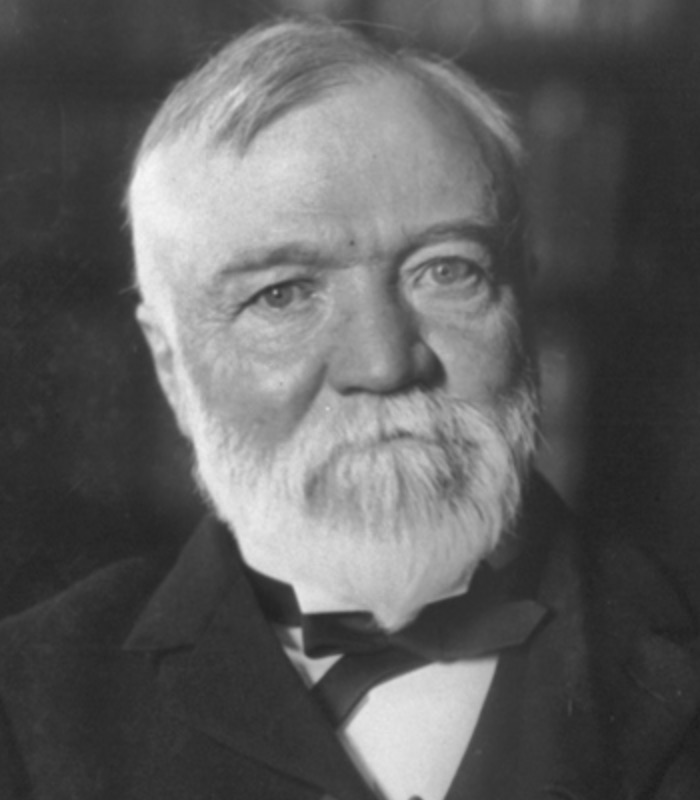
Andrew Carnegie was born on November 25, 1835, in Dunfermline, Scotland, to a poor family. In 1848, at the age of 12, Carnegie and his family emigrated to the United States, settling in Allegheny City, Pennsylvania. Andrew began his career as a bobbin boy in a cotton factory, where he changed spools of thread in a Pittsburgh cotton mill, working 12 hours a day, 6 days a week. He was paid $1.20 per week for this, which corresponds to about $44 in today’s dollars.
In 1849, he became a telegraph messenger boy for the Ohio Telegraph Company at $2.50 per week ($92 in today’s dollars). During this time, Colonel James Anderson, an educator and owner of several private schools made his library available to young working boys on Saturday evenings. Andrew, who was a voracious reader, used the library to educated himself in a variety of subjects.
Andrew got his first job in the railroad industry in 1853 as a messenger and telegraph operator at $4.00 per week ($147 in today’s dollars) for the Pennsylvania Railroad. He showed such commitment and ability that, on December 1, 1859, Thomas A. Scott, an executive in the Pennsylvania Railroad, appointed him, at the age of 24, to Superintendent of the Western Division of the Pennsylvania Railroad. In his new position, Andrew was earning a salary of $1500.00 per year (equivalent to about $55,000 per year in today’s dollars).
In 1855, Scott encouraged Andrew to invest $500 in the Adams Express Company in a transaction that might be regarded today as insider trading. Carnegie’s mother put a mortgage on the family house to raise the money for that investment. As Carnegie slowly accumulated capital, his connections with Scott and others helped him build an investment portfolio that would soon grow into a sizeable holding.
Through the 1850’s the railroads were becoming the first big business in America, and Carnegie was investing in the companies that supplied steel for the construction of bridges and rails. While still working for Thomas Scott and the Pennsylvania Railroad, Carnegie negotiated a merger between the Woodruff sleeping car company and the Pullman company that had invented the sleeping car.
In early 1861 at the outbreak of the Civil War, Thomas Scott was appointed Assistant Secretary of War and he appointed Carnegie as his Superintendent of the Military Railways and the Union Government’s eastern telegraph lines. When the Union army was defeated at the Battle of Bull Run, Carnegie played a major role in overseeing the repair of the damaged railroad lines and evacuating the troops.
Carnegie’s most significant contribution to American industry came through his involvement in the steel industry. During the Civil War, he had worked with others in the development of a mill for rolling steel that was needed for the construction of gunboats, cannons and shells. After the War, he left the Pennsylvania Railroad Company to establish his own Keystone Bridge Company and Union Ironworks. During the 1870s, he innovated the production of steel by adapting the Bessemer smelting process whereby the high carbon content in the pig iron is melted away to create a harder steel. After consolidating his various steel enterprises into the Carnegie Steel Company, that became one of the world’s largest and most profitable steel companies, Andrew Carnegie became one of the world’s wealthiest men.
Having achieved this wealth, Carnegie enunciated in 1889 his “Gospel of Wealth,” asserting that the wealthy have a moral obligation to use their wealth to benefit society. Two years later, he sold his steel company to J.P. Morgan and retired from business at age 56. He subsequently became a renowned philanthropist, donating a significant portion of his wealth to various causes, including the construction of thousands of libraries worldwide, as well as educational institutions. In 1911, he established the Carnegie Corporation of New York, a philanthropic foundation dedicated to the advancement of education and knowledge. Carnegie became an advocate for international peace and disarmament. He funded the construction of the Peace Palace at The Hague, that houses the International Court of Justice.
Reflecting on his struggle from poverty to great wealth, Carnegie once stated, “People who are unable to motivate themselves must be content with mediocrity, no matter how impressive their other talents.”
Andrew Carnegie died of bronchial pneumonia on August 11, 1919, at his Shadow Brook estate in Lenox, Massachusetts, leaving a complex legacy. While he is remembered for his vast philanthropic contributions, particularly to education and libraries, his business practices and the labor conditions in his steel mills were controversial.
